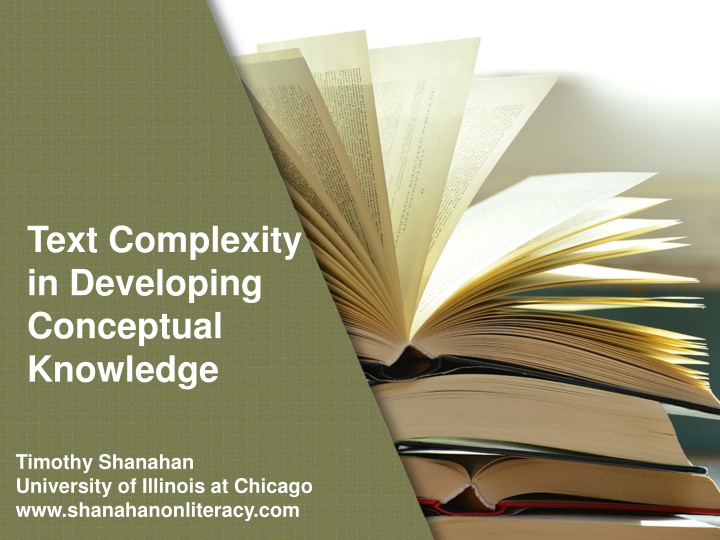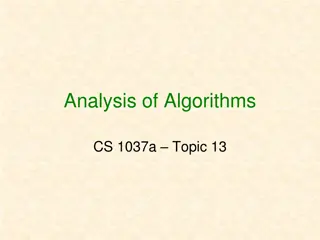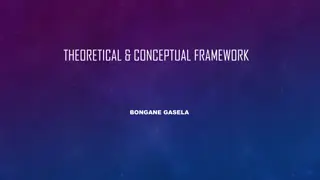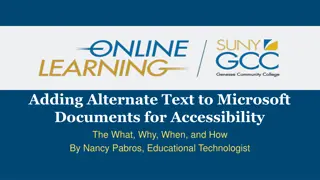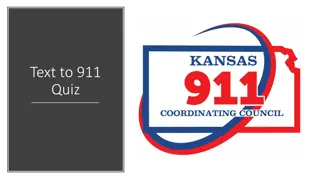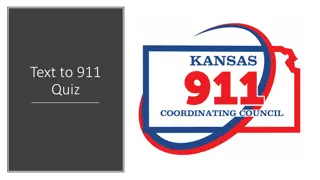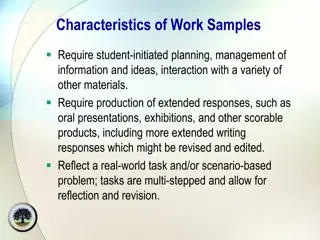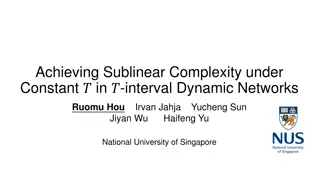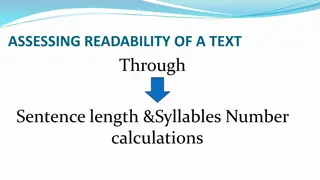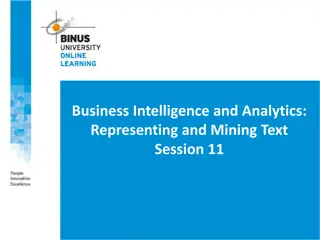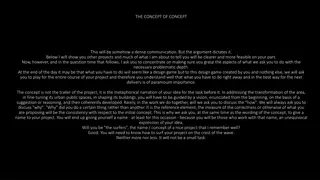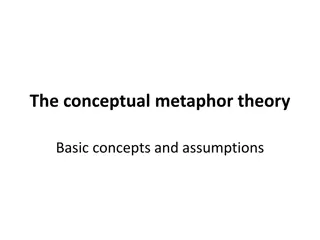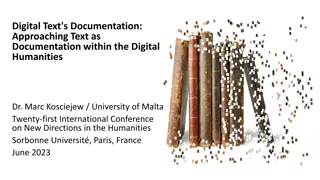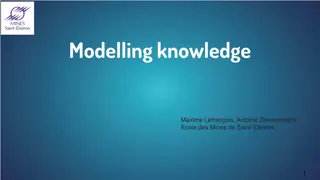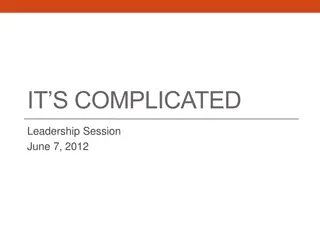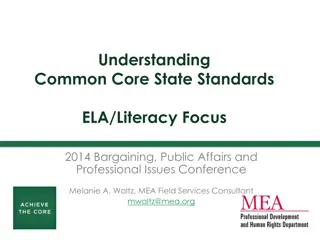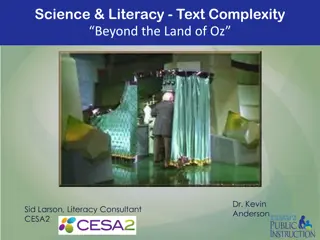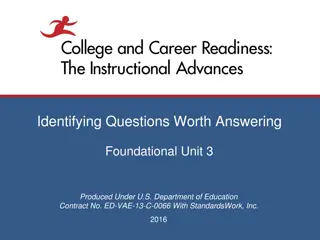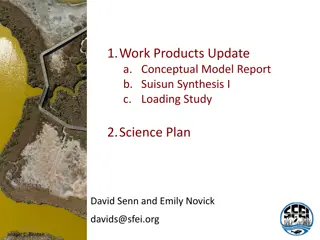The Role of Text Complexity in Developing Conceptual Knowledge
Conceptual learning involves organizing new information into mental structures, focusing on big ideas and themes. While text complexity is often seen as a barrier to learning, it is essential for promoting high-level academic learning. Complex ideas require complex text that explains extensive information and interrelationships. Teachers and researchers approach dealing with complex texts differently, aiming to make them more readable or provide accommodations. However, text remains central to how disciplinary experts create, communicate, and evaluate knowledge.
Download Presentation

Please find below an Image/Link to download the presentation.
The content on the website is provided AS IS for your information and personal use only. It may not be sold, licensed, or shared on other websites without obtaining consent from the author.If you encounter any issues during the download, it is possible that the publisher has removed the file from their server.
You are allowed to download the files provided on this website for personal or commercial use, subject to the condition that they are used lawfully. All files are the property of their respective owners.
The content on the website is provided AS IS for your information and personal use only. It may not be sold, licensed, or shared on other websites without obtaining consent from the author.
E N D
Presentation Transcript
Text Complexity in Developing Conceptual Knowledge Timothy Shanahan University of Illinois at Chicago www.shanahanonliteracy.com
Conceptual Knowledge Conceptual learning is a process by which students learn new information that organizes that information into logical mental structures Conceptual learning focuses on big ideas, themes, and the like rather than lists of facts (though it depends on and subsumes such facts) Learning that requires an understanding of the significance of the points and their interrelationships
Text as Barrier The basic premise of most treatments of text complexity is that it is potential barrier to conceptual learning The basic approach taken both by teachers and researchers is that text can be hard to read and, consequently, it stands in the way of conceptual learning
How Teachers Deal with Complex Text Move kids to easier texts Read the texts to students Tell students what the texts say Ignore that students can t read the text
How Researchers Deal with Complex Text Readability measures for identifying texts to be avoided (e.g., Lexiles, Fry) Revision approaches aimed at revising texts to make them more readable (Beck, et al., 1991; Duffy, et al., 1989; Graves, 1988) Promotion of schemes to protect students from having to read complex texts (e.g., jigsawed text sets, guided reading, reading accommodations)
But Complex Text is Essential This presentation is based upon a different premise Instead of viewing text as a barrier to student learning, let s start with the idea that high level academic learning can only be promoted meaningfully through the use of text Text is central to how disciplinary experts create knowledge, communicate that knowledge, and evaluate knowledge
Complex Ideas Require Complex Text Second premise: In general, the more complex the ideas, the more complex the text Complexity refers to the extensiveness of the information and the extensiveness and diversity of the interrelationships of that information (com: together; plex: woven) Explanations of gravity are usually going to be more simple than explanations of relativity, etc.
Any Text Feature Can Be a Barrier Text also can be complex due to language demands and intricate or sophisticated text features These elements are used by authors in an effort to clarity But any feature that can be facilitative for one reader is a potential barrier to communication for another
Conclusion To promote deep, high level, conceptual, academic learning students need to read If content is deep, high level, conceptual, etc., the texts will be complex Complexity of content, language, and text will facilitate communication for some, but will block others Need to provide instructional supports that allow students to make sense of text without reading it for them or telling them what it says
Instructional Level Theory Those premises or claims are pretty tame And, yet, they challenge one of the most cherished theories of the reading community Instructional level theory claims that learning can only take place if students read texts at their instructional levels (Betts, 1946) Thus, good teachers seek out easier books so that their students can read them with certain l evels of performance
Reading Experts Champion Theory William S. Gray Edward Thorndike Arthur Gates Edward Dolch Albert J. Harris Marion Monroe Paul Witty Ruth Strang George Spache Donald Durrell Richard Allington Irene Fountas Gay Su Pinnell John J. Pikulski Richard Vacca Morton Botel Jerry Johns Roger Farr Jack Cassidy Guy Bond
Many Programs Based on It ,Too Guided Reading Book Bands Accelerated Reader Corrective Reading Academy of Reading Reading Recovery Success for All Lexiles Mastery Learning Core Reading Progams (HMH, MH, SF) Reading Workshop
Matching Texts to Kids Betts (1946): informal reading inventories used to estimate students reading levels Independent (fluency 99-100%; comprehension 90-100%) Instructional (fluency 95-98%; comprehension 75-89%) Frustration (fluency 0-92%; comprehension 0-50%) Validated by Killgallon (1941) study
But That Study Didnt Look at Learning Killgallon administered IRIs to a small group of fourth-graders to see the relationship between comprehension (75-89%) with ency They didn t remember later where those comprehension estimates came from They never looked at learning flu
Studies Dont Support Leveling Powell (1968): same method as Killgallon, but more grade levels and different results Dunkeld (1972): looked at learning and found instructional levels similar to Powell s estimates Jorgensen, et al. (1977): no relation between placement and achievement gains Morgan, et al. (2000): frustration level placements led to greater learning gains O Connor et al (2002, 2010): only benefit was for students reading at grade 1 level, but this benefit went away if scaffolding was equated Kuhn et al (2006): grade level placements led to greater learning gains
What Does That Mean? Research finds no learning benefit from matching texts to student reading levels
Scaffolding Instructional Levels Bonfiglio, Daly, Persampieri, & Andersen, 2006 Burns, 2007 Burns, Dean, & Foley, 2004 Carney, Anderson, Blackburn, & Blessings, 1984 Daly & Martens, 1994 Eckert, Ardoin, Daisey, & Scarola, 2000 Faulkner & Levy, 1999 Gickling & Armstrong, 1978 Hall, Sabey, & McClellan, 2005 Levy, Nicholls, & Kohen, 1993 McComas, Wacker, & Cooper, 1996 Neill, 1979
Scaffolding Instructional Levels O Shea, Sindelar, & O Shea, 1985 Pany & McCoy, 1988 Rasinski, 1990 Reitsma, 1988 Rose & Beattie, 1986 Sanford & Horner, 2013 Sindelar, Monda, & O Shea, 1990 Smith, 1979 Stoddard, Valcante, Sindelar, O Shea, et al., 1993 Taylor, Wade, & Yekovich, 1985 Turpie & Paratore, 1995 VanWagenen, Williams, & McLaughlin, 1994 Weinstein & Cooke, 1992 Wixson, 1986
Disciplinary Language Disciplines represent cultural differences in how information is used, the nature of language (e.g., vocabulary, morphemes, grammar), text formatting and features, demands for precision, interpretive elements, etc. Disciplines use language differently and this can benefit from scaffolding
Science Example Science language differs from conversation, fiction, and even other informational and academic texts Science text has changed over time and is still changing Grammatical complexity in Academic English (2016) Douglas Biber & Bethany Gray Quantitative linguistics comparative and historical analyses of language
Grammatical features in academic prose Nouns and noun phrases Nouns: overall ~60% of all content words in academic prose are nouns Nouns much more common than pronou ns Generally rare in academic prose Much more common in academic prose (this is used for textual reference; one use dfor general rather than specific reference Nouns vs. pronouns Absence of pronouns Specific pronouns: this, and one Plural nouns Much more common in writing than conv ersation, used most in academic Much more common in academic (especially with tion, -ity Usually expressed with a determiner + noun (rather than pronoun) Nominalizations Anaphoric expressions
Grammatical features in academic prose (cont.) Nouns and noun phrases (cont.) Nouns and/or noun binomial phrases Much more common in academic prose
Grammatical features in academic prose (cont.) Nouns and noun phrases (cont.) Definite article: the Much more common in writing than conversation, most common in academic prose Most common in academic prose (thi s and these) 60% of all noun phrases in academic prose have a modifier Common in academic prose and new spapers Very common in academic prose Very common in academic prose and newspapers Most common in academic prose Demonstrative determiners Noun phrases with modifiers Noun phrases with pre-modifiers Nouns as pre-modifiers Noun phrases with post-modifiers Noun phrases with multiple pre- modifiers
Grammatical features in academic prose (cont.) Adjecties and adjective phraes Adjectives overall Much more common in academic prose than fiction or conversation Much more common in academic prose More in academic particularly: different, important, difficult, possible, necessary, available, useful Much more common in academic prose (especially adjectives form with -al) Attributive adjectives Specific predicative adjectives Derived adjectives
Grammatical features in academic prose (cont.) Verbs and verb phrases Copula be copular verb become Existence verbs Most common in academic prose Much more common in writing than conversation (most common in acad emic: e.g., include, involve, indicate) Several verbs more common in academic prose: Activity verbs: use, produce, provide, apply, form, obtain, reduce Communication verbs: describe, suggest Mental verbs: consider, assume, determine Causative/Occurrence/Existence verbs: follow, allow, require, include, involve, contain, exist, indicate, represent Specific lexical verbs
Grammatical features in academic prose (cont.) Verbs and verb phrases (cont.) Specific prepositional verbs Many p. verbs are more frequent in academic text: Activity: deal with, be applied to, be used in, be derived from Communication: refer to Mental: be known as Causative/Occurrence/Existence: lead to, result in, occur in, depend on, con sist of, be based on, be associated wit h, be related to Common only in academic prose (e.g. , such comparisons, suggest .) More common in academic prose, especially verbs formed with re- and -ize Verbs with inanimate subjects Derived verbs
Grammatical features in academic prose (cont.) Verbs and verb phrases (cont.) Tense and aspect Academic prose relies primarily on simple aspect, present tense verb phrases Passive voice Much more common in academic prose Several verbs are especially common in this: BE+made, given, taken, used, found, seen, considered, shown Specific passive verbs
Grammatical features in academic prose (cont.) Adverbs and adverbials Specific adverbs Notably more common in academic prose: often, usually, significantly more, relatively, especially, particularly, generallly, indeed A few notably more common in academic prose: extremely, highly A few are more common relatively, fairly, slightly More common in academic prose, especially: however, thus, therefore, for example Most common in academic prose (e.g., in order to, although) Specific amplifiers Specific degree adverbs Linking adverbials Purpose and concessive adverbials
Dependent clause features Finite relative clauses with adverbial gaps Grammatical features in academi c prose (cont.) Most common in academic prose; es pecially with in which (e.g., a mutant viemntin in which Ser82 is changed t o S82E) Very common in academic prose and newspapers (e.g., the assumptions giv en above) Very common in academic prose (e.g. , the fact that, a possibility that, no d oubt that) Very common in academic prose (an attempt to, the ability to) Very common in academic prose, especially with head nouns: way, cost, means, methods, possibility, effect, probelem, process, rule (methods of assessing error) Participle clauses as post-modifiers in noun phrases Noun complement clauses with a tha t-clause Noun complement clauses with a to-clause Abstract noun + of + ing-clause
Grammatical features in academic prose (cont.) Dependent clause features (cont.) Extraposed that-clauses Most common in academic prose, esppecially controlled by the adjectives clear, unlikely, likely, and possible and impossible Most common in academic prose, es pecially controlled by adjectives Common only in academic prose (an d newspapers) (e.g., The first step is t o evaluate the expression) Most common in academic prose (e.g ., capable of, important for/in, useful f or/in, formalist stragegies are useful f or analyzing drama) Most common in academic prose (th ough, although) Extraposed to-clauses Subject predicative to-clauses Ing-clauses controlled by adjective predicates Concessive adverbial clauses
Grammatical features in academic prose (cont.) Other features Prepositions Most common in academic prose Of-phrases MosMuch more common in writing t han oral language; most common in academic prose Very common in academic prose (e.g, the effect on the final state) Most common in academic prose, es pecially possibility of, value of, import ance of, problem of, understanding of Common only in academic prose Prepositional phrases as post- modifiers in noun phrases Stance noun + of-phrase That/those + of-phrase
Grammatical features in academic prose (cont.) Other features (cont.) Preposition + which in relative clause s with adverbial gaps Selected coordination tags Common only in academic prose, especially in which and to which Common only in academic prose (etc. ) Most common in academic prose Qualifier each Semi-determiners same, other, certain , and such Dual gender referece Much more common in academic pro se Common only in academic prose Lexical bundles with noun phrases an d/or prepositional phrases Very common in academic prose (e.g. , the end ot the, the nature of the, on e of the most, the way in which, the extent to which, the fact that the, as a result of, at the same time of, on t he other hand)
Specifics of Science Technical, abstract, dense, tightly knit language (that contrasts with interactive, interpersonal style of other texts or ordinary language) More nouns, fewer verbs more noun modification (Philae comet lander alien cover-up conspiracy theories emerge Nominalization (turning processes and properties into nouns) Passive voice ( the atoms were excited by the heat ) Suppression of agency (readers need to focus on causation not intention) Phrasal complexity instead of clausal complexity Reduction in conjunctions and specialized use of colons
Scaffolding Challenging Text Scaffolding Text Features Complexity of ideas/content Match of text and reader prior knowledge Complexity of vocabulary Complexity of syntax Complexity of coherence Familiarity of genre demands Complexity of text organization Subtlety of author s tone Sophistication of literary devices or data-presentation devices Other Approaches Provide sufficient fluency Use stair-steps or apprentice texts Teach comprehension strategies Motivation
Tell Vocabulary Texts can be hard because of unfamiliar vocabulary (difference between academic vocabulary and key vocabulary in a text) Less widely known words tend to be harder than know n words Metaphorical language counts as vocabulary too ( common currency , charming and charmed innocence ) But not all of the words have the same impact on the information or comprehension of the information Carefully analyze text for the challenging and importan t vocabulary emphasize the words that influence the meaning
Which words do you teach? Photosynthesis may sound like a big word, but it's actually pretty simple. You can divide it into two part s: "Photo" is the Greek word for "Light," and "synthes is," is the Greek word for "putting together," which explains what photosynthesis is. It is using light to pu t things together. You may have noticed that all animals and humans eat food, but plants don't eat anything. Photosynthesis is how plants eat. T hey use this process to make their own food . Since they don't have to move around to find food, plants stay in one place, since they can make their f ood anywhere as long as they have three things.
Which words do you teach? Photosynthesis may sound like a big word, but it's actually pretty simple. You can divide it into two part s: "Photo" is the Greek word for "Light," and "synthes is," is the Greek word for "putting together," which explains what photosynthesis is. It is using light to pu t things together. You may have noticed that all animals and humans eat food, but plants don't eat anything. Photosynthesis is how plants eat. T hey use this process to make their own food . Since they don't have to move around to find food, plants stay in one place, since they can make their f ood anywhere as long as they have three things.
Which words would you teach? Some scientists argued that these gases have heated up our atmosphere. They say global warming will affect our climate so dramatically that glaciers will melt and sea lev elswill rise. In addition, it is not just our atmosphere that can be polluted. Oil from spills often seeps into the oc ean.
Which words would you teach? Some scientists argued that these gases have heated up our atmosphere. They say global warming will affect our climate so dramatically that glaciers will melt and sea lev elswill rise. In addition, it is not just our atmosphere that can be polluted. Oil from spills often seeps into the oc ean.
Which words would you teach? I can never forget the scene that met us. Between us and the Barrier was a lane of some fifty yards wide, a seethin g cauldron. Bergs were calving off as we watched: and capsizing: and hitting other bergs, splitting into two and falling apart. The Killers filled the whole place. Looking downwards into a hole between our berg and the next, a hole not bigger than a small room, we saw at least six whales. They were so crowded that they could only lie so as to get their snouts out of the water and my memory i s that their snouts were bottle-nosed. At this moment our berg split into two parts and we hastily retreated to the lower and safer floes.
Which words would you teach? I can never forget the scene that met us. Between us and the Barrier was a lane of some fifty yards wide, a seethin g cauldron. Bergs were calving off as we watched: and capsizing: and hitting other bergs, splitting into two and falling apart. The Killers filled the whole place. Looking downwards into a hole between our berg and the next, a hole not bigger than a small room, we saw at least six whales. They were so crowded that they could only lie so as to get their snouts out of the water and my memory i s that their snouts were bottle-nosed. At this moment our berg split into two parts and we hastily retreated to the lower and safer floes.
Help with Sentence Structure Texts may be hard because of grammar or syntax Explain clearly using at least three different reasons or drawing three diagrams why McClellan lost the battle. Explain clearly why McClellan lost the battle. Give at least three reasons or draw three diagrams.
Help with Sentence Structure Guide students to interpret complex sentences (clause and phrase analysis) However, on August 24, 2006, the International Astronomical Union (IAU), a group of individual astronomers and astronomical societies from around the world, made an announcement.
However, on August 24 2006 the International Astronomical Union (IAU), a group of individual astronomers and astronomical societies from around the world made an announcement
Who was the sentence about? the International Astronomical Union (IAU) Who are they? a group of individual astronomers and astronomical societies from around the world What did they do? made Made what? an announcement When? on August 24 2006
Another example The women of Montgomery, both young and older, wou ld come in with their fancy holiday dresses that needed adjustments or their Sunday suits and blouses that neede d just a touch a flower or some velvet trimming or something to make the ladies look festive. --Nikki Giovanni (Rosa) 44 words 2 commas, 1 em-dash
Another example The women of Montgomery , both young and older, w ould come in with their fancy holiday dresses that neede d adjustments or their Sunday suits and blouses th at needed just a touch a flower or some velvet trimmin g or something to make the ladies look festiv e.
Another example The women of Montgomery would come in with their fa ncy holiday dresses that needed adjustments or their Sun day suits and blouses that needed just a touch a flow er or some velvet trimming or something to make th e ladies look festive.
Another example The women of Montgomery would come in with their fa ncy holiday dresses that needed adjustments or their Sun day suits and blouses that needed just a touch a flow er or some velvet trimming or something to make the la dies look festive.
Another example The women of Montgomery would come in with their fa ncy holiday dresses that needed adjustments or their Sunday suits and blouses that needed just a touc h a flower or some velvet trimming or something to make the ladies look festive.
